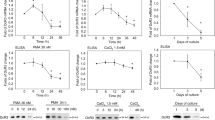Abstract
The Fas antigen is a cell surface protein that can mediate apoptosis in many cell types. Although its physiological function is still unclear, recent evidence indicates that this surface molecule is involved in apoptosis in the immune system and the liver. The epidermis is an organ that undergoes terminal differentiation with the eventual death of keratinocytes, and it has been suggested that this is a specialized form of apoptosis. In the present study, we examined whether or not the Fas antigen is involved in keratinocyte apoptosis. Immunoreactivity for the Fas antigen was found throughout the epidermis in normal human skin sections and cultured normal human keratinocytes, and mRNA for the Fas antigen was found to be constitutively expressed in normal epidermis and cultured normal keratinocytes by RT-PCR analysis. To determine whether the Fas antigen in keratinocytes is functional, we used a cytotoxic monoclonal antibody (mAb) against the Fas antigen to induce apoptosis. This antibody did not induce apoptosis of cultured keratinocytes even though they expressed the Fas antigen. We then tested the ability of several cytokines (TGFβ, TNFα and IFNγ) to induce Fas-mediated keratinocyte apoptosis. Only pretreatment with IFNγ followed by the addition of the anti-Fas mAb induced apoptosis, as assessed by cell viability, morphological changes and ultrastructural characteristics, suggesting that constitutive expression of the Fas antigen is not sufficient to induce apoptosis in keratinocytes and that keratinocyte apoptosis via the Fas antigen-mediated mechanism may require the activation of keratinocytes by IFNγ, which is thought to be produced by activated T cells. The Fas antigen may not be related to keratinocyte apoptosis that occurs in terminal differentiation, but rather to the apoptosis that occurs in inflammatory skin diseases.
Similar content being viewed by others
References
Haake AR, Polakowska RR (1993) Cell death by apoptosis in epidermal biology. J Invest Dermatol 101: 107–112
McCall CA, Cohen JJ (1991) Programmed cell death in terminally differentiating keratinocytes: Role of endogenous endonuclease. J Invest Dermatol 97: 111–114
Itoh N, Yonehara S, Ishii A, Yonehara M, Mizushima S, Sameshima M, Hase A, Seto Y, Nagata S (1991) The polypeptide encoded by the cDNA for human cell surface antigen Fas can mediate apoptosis. Cell 66: 233–243
Oehm A, Behrmann I, Falk W, Maier G, Klas C, Li-Weber M, et al (1992) Purification and molecular cloning of the APO-1 antigen, an new member of the TNF/NGF receptor superfamily: sequence identity with the Fas antigen. J Biol Chem 267: 10709–10715
Watanabe-Fukunaga R, Brannan CI, Itoh N, Yonehara S, Copeland NG, Jenkins NA, Nagata S (1992) The cDNA structure, expression, and chromosomal assignment of the mouse Fas antigen. J Immunol 148: 1274–1279
Watanabe-Fukunaga R, Brannan CI, Copeland NG, Jenkins NA, Nagata S (1992) Lymphoproliferation disorder in mice explained by defects in Fas antigen that mediates apoptosis. Nature 356: 314–317
Ogasawara J, Watanabe-Fukunaga R, Adachi M, Matsuzawa A, Kasugai T, Kitamura Y, Itoh N, Suda Y, Nagata S (1993) Lethal effect of the anti-Fas antibody in mice. Nature 364: 806–809
Suda T, Takahashi T, Golstein P, Nagata S (1993) Molecular cloning and expression of the Fas ligand, a novel member of the tumor necrosis factor family. Cell 75: 1169–1178
Hartfield C, McDowall A, Loveland B, Fischer Lindahl K (1991) Cellular location of thymus-leukemia (TL) antigen as shown by immunocryoultramicrotomy. J Electron Microsc Tech 18: 148–158
Matsue H, Bergstresser PR, Takashima A (1993) Keratinocyte-derived IL-7 as a growth factor for dendritic epidermal T cells in mice. J Immunol 151: 6012–6019
Kobayashi H, Yasuda H, Matsue H, Ohkawara A, Ogiso Y, Kuzumaki N (1990) Epidermal growth factor receptor mRNA is not increased in psoriatic skin. J Dermatol 17: 104–107
Matsue H, Rothberg KG, Takashima A, Kamen BA, Anderson RGW, Lacey SW (1992) Folate receptor allows cells to grow in low concentrations of 5-methyltetrahydrofolate. Proc Natl Acad Sci USA 89: 6006–6009
Golstein P, Ojcius DM, Young JDE (1991) Cell death mechanisms and the immune system. Immunol Rev 121: 29–65
Yonehara S, Ishii A, Yonehara M (1989) A cell-killing monoclonal antibody (Anti-Fas) to a cell surface antigen co-down-regulated with the receptor of tumor necrosis factor. J Exp Med 169: 1747–1756
Trauth BC, Klas C, Peters AMJ, Matzku S, Möller P, Falk W, et al (1989) Monoclonal antibody-mediated tumor regression by induction of apoptosis. Science 245: 301–305
Stalder T, Hahn S, Erb P (1994) Fas antigen is the major target molecule for CD4+ T cell-mediated cytotoxicity. J Immunol 152: 1127–1133
Russell JH, Rush B, Weaver C, Wang R (1993) Mature T cells of autoimmunelpr/lpr mice have a defect in antigen-stimulated suicide. Proc Natl Acad Sci USA 90: 4409–4413
Rouvier E, Luciani MF, Golstein P (1993) Fas involvement in Ca2+-independent T cell-mediated cytotoxicity. J Exp Med 177: 195–200
Luger TA, Schwarz T (ed) (1994) Epidermal growth factors and cytokines. Marcel Dekker, New York
Matsue H, Cruz PD Jr, Bergstresser PR, Takashima A (1992) Cytokine expression by epidermal cell subpopulations. J Invest Dermatol 99: 42S-45S
Barker JNWN, Navsaria HA, Leigh IM, MacDonald DM (1988) Gamma-interferon induced human keratinocyte HLA-DR synthesis: the role of dermal activated T lymphocytes. Br J Dermatol 119: 567–572
Dustin ML, Singer KH, Tuck DT, Springer TA (1988) Adherence of T lymphoblasts to epidermal keratinocytes is regulated by IFN-γ and is mediated by ICAM-1. J Exp Med 167: 1323–1340
Nickoloff BJ (1987) Binding125I-IFN gamma interferon to cultured human keratinocytes. J Invest Dermatol 89: 132–135
Barker JNWN, Sarma V, Mitra RS, Dixit VM, Nickoloff BJ (1990) Marked synergism between tumor necrosis factor-α and interferon-γ in regulation of keratinocyte-derived adhesion molecules and chemotactic factors. J Clin Invest 85: 605–608
Alderson MR, Armitage RJ, Maraskovsky E, Tough TW, Roux E, Schooley K, Ramsdell F, Lynch DH (1993) Fas transduces activation signals in normal human T lymphocytes. J Exp Med 178: 2231–2235
Author information
Authors and Affiliations
Rights and permissions
About this article
Cite this article
Matsue, H., Kobayashi, H., Hosokawa, T. et al. Keratinocytes constitutively express the Fas antigen that mediates apoptosis in IFNγ-treated cultured keratinocytes. Arch Dermatol Res 287, 315–320 (1995). https://doi.org/10.1007/BF01105085
Received:
Issue Date:
DOI: https://doi.org/10.1007/BF01105085




